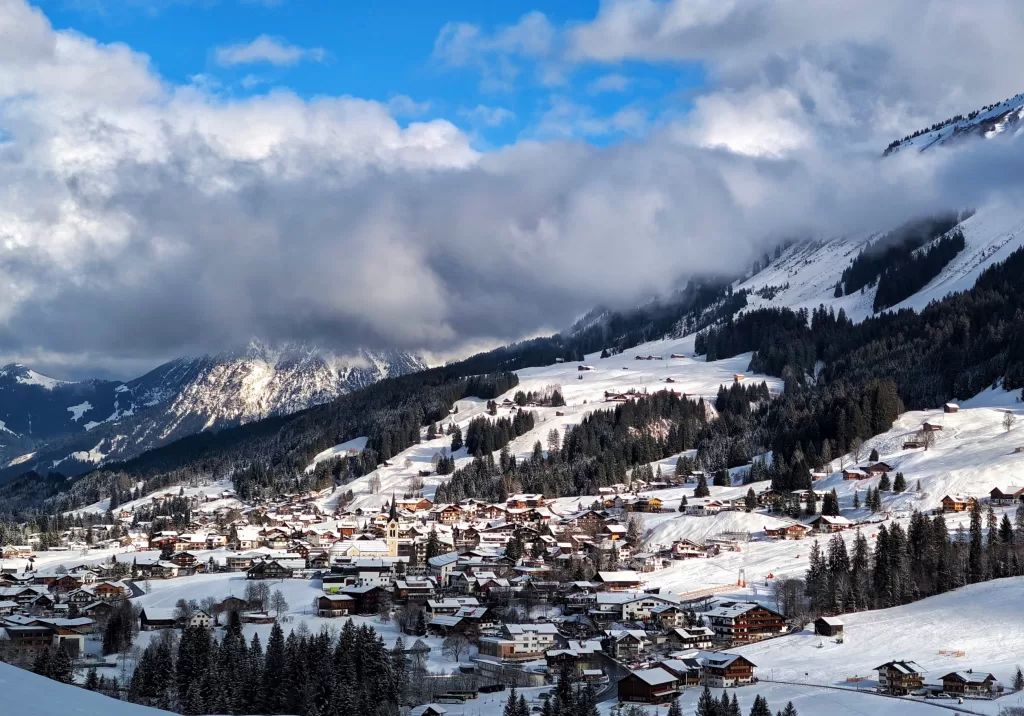 Kleinwalsertal is an Alpine valley in Austria, uniquely accessible only from Germany. Yes, this enclave is a geographical curiosity, entirely separated from the rest of Austria. Nestled in the Alps, it’s a prime spot for skiing. My husband had a conference in Hirschegg, which offered us a fantastic opportunity to reconnect with the mountains – a sentiment I’ve shared in a previous blog about Garmisch-Partenkirchen.
Kleinwalsertal is an Alpine valley in Austria, uniquely accessible only from Germany. Yes, this enclave is a geographical curiosity, entirely separated from the rest of Austria. Nestled in the Alps, it’s a prime spot for skiing. My husband had a conference in Hirschegg, which offered us a fantastic opportunity to reconnect with the mountains – a sentiment I’ve shared in a previous blog about Garmisch-Partenkirchen.
Best time to visit: Winter 🏂🏼 & (perhaps) Summer ⛰️
While the alpine region is breathtaking from late spring to winter, Kleinwalsertal becomes a tourist hotspot primarily in the winter for skiing. Consequently, many local businesses, including restaurants and shops, operate mainly during the ski season. I personally don’t ski, finding it somewhat dangerous, but the area has a variety of other activities. Summer, too, is ideal for hiking in the Alps, though it’s advisable to verify the availability of hiking gear in advance.
How to get there:
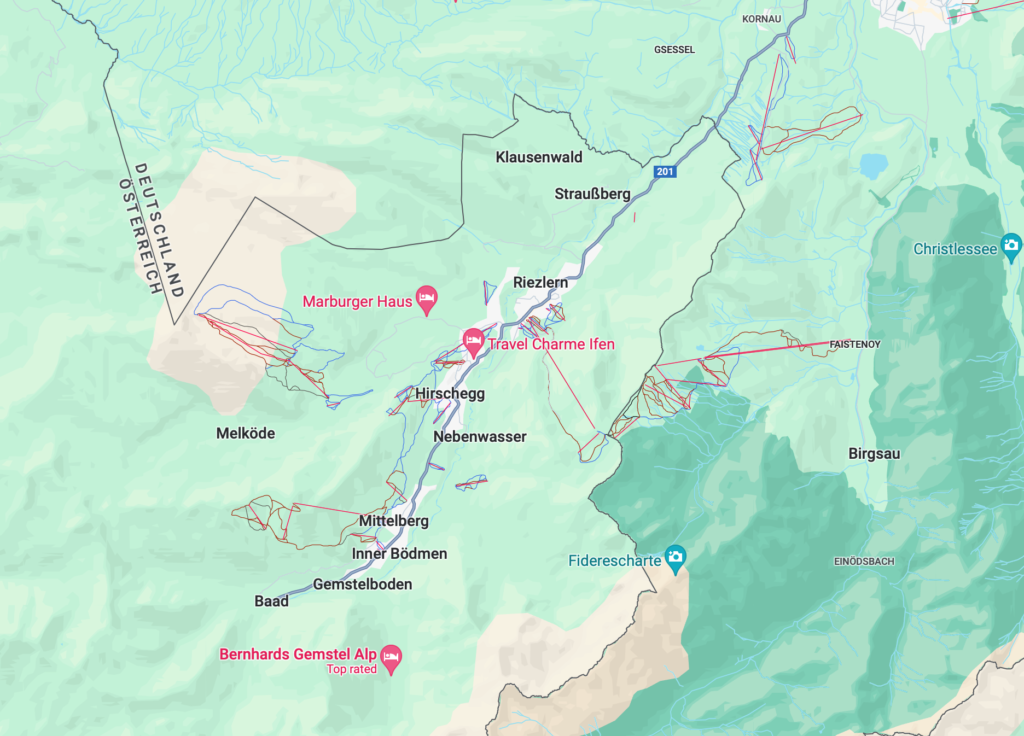 Bayern (Bavaria) is well-connected, with routes from München Hbf (Munich’s main station) leading nearly everywhere in the region. To reach Kleinwalsertal, take one of the various trains from Munich to Oberstdorf, the nearest major town at the German-Austrian border. For precise train connections and schedules, consult Deutsche Bahn’s website. Upon arrival at Oberstdorf Busbahnhof (bus station), take Bus 1 towards Kleinwalsertal Baad, Österreich.
Bayern (Bavaria) is well-connected, with routes from München Hbf (Munich’s main station) leading nearly everywhere in the region. To reach Kleinwalsertal, take one of the various trains from Munich to Oberstdorf, the nearest major town at the German-Austrian border. For precise train connections and schedules, consult Deutsche Bahn’s website. Upon arrival at Oberstdorf Busbahnhof (bus station), take Bus 1 towards Kleinwalsertal Baad, Österreich.
As noted earlier, Kleinwalsertal comprises a sequence of small villages stretched along a main road. Bus 1 conveniently carries passengers from Riezlern, at the valley’s entrance, to Baad, at its terminus.
Let me guide you through what I believe are the best activities in Kleinwalsertal:
Hiking Opportunities:
Surrounded almost entirely by the Allgäu Alps, Kleinwalsertal offers an abundance of hiking trails suitable for both winter and summer excursions. We received a hiking guide from our accommodation, however, the Kleinwalsertal Official Website provides a wealth of information on trails that are accessible online at no charge. During my stay, I embarked on two distinct trails, one around Baad and another near Mittelberg.
Baad
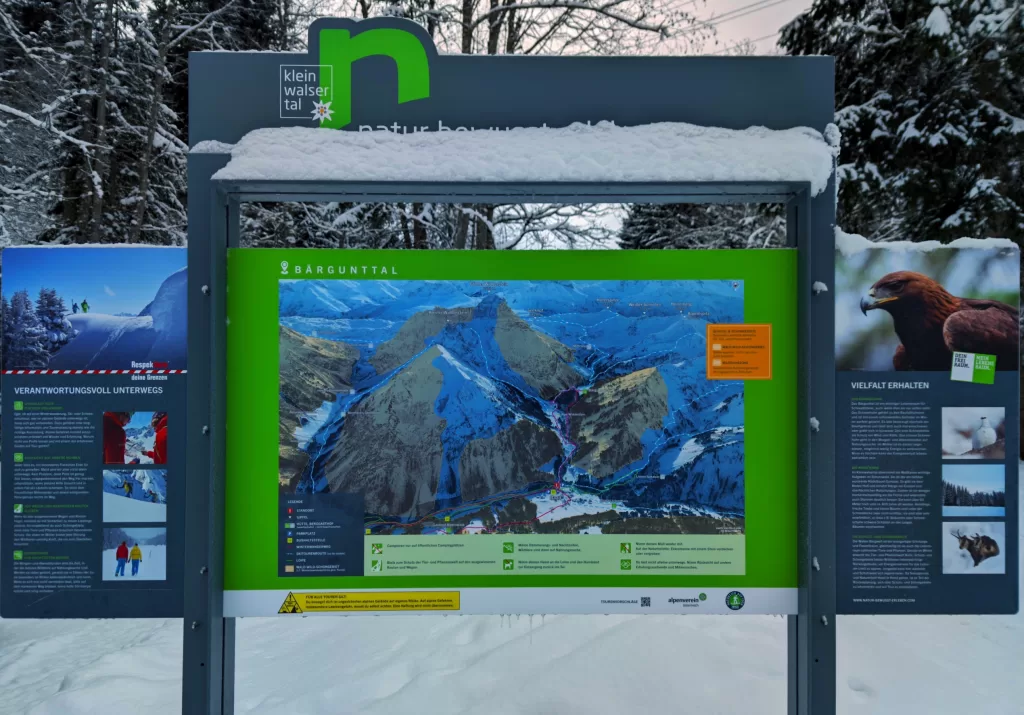 Situated at the very end of the valley, Baad may give the deceptive impression of proximity to the other side of the country. Yet, when you arrive, you’re greeted by an imposing mountain range that blocks passage.
Situated at the very end of the valley, Baad may give the deceptive impression of proximity to the other side of the country. Yet, when you arrive, you’re greeted by an imposing mountain range that blocks passage.
My adventure in Baad was rather spontaneous: I chose a path at random and let it guide me. The journey began at the Baad bus stop, located at the head of a trail. After snapping a photo of the trail map, I set off.
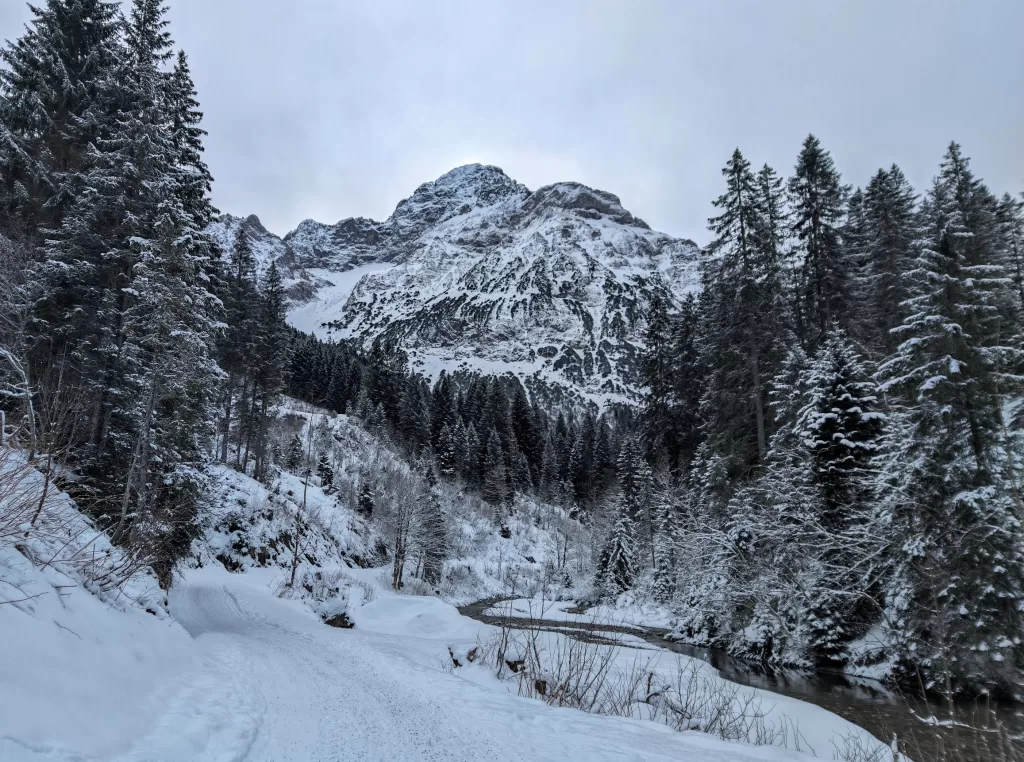
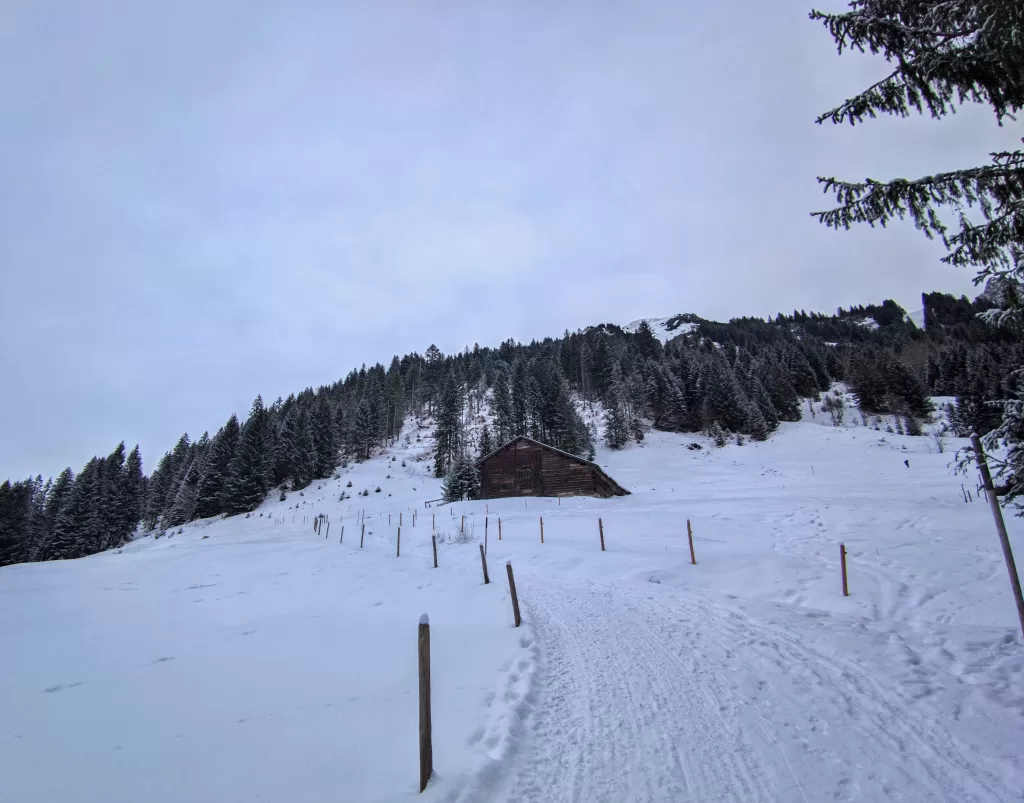 The path commenced alongside a creek – a flat and easy walk that soon became dull. Seeking more excitement, I found an opportunity to ascend at a junction. For those less inclined towards strenuous hikes, continuing along the creek remains a pleasant option. Although I’m not an avid hiker like the locals, the attraction of a mountain vista from higher ground was irresistible.The initial climb was sharp, offering rapid views of the surrounding peaks.
The path commenced alongside a creek – a flat and easy walk that soon became dull. Seeking more excitement, I found an opportunity to ascend at a junction. For those less inclined towards strenuous hikes, continuing along the creek remains a pleasant option. Although I’m not an avid hiker like the locals, the attraction of a mountain vista from higher ground was irresistible.The initial climb was sharp, offering rapid views of the surrounding peaks. 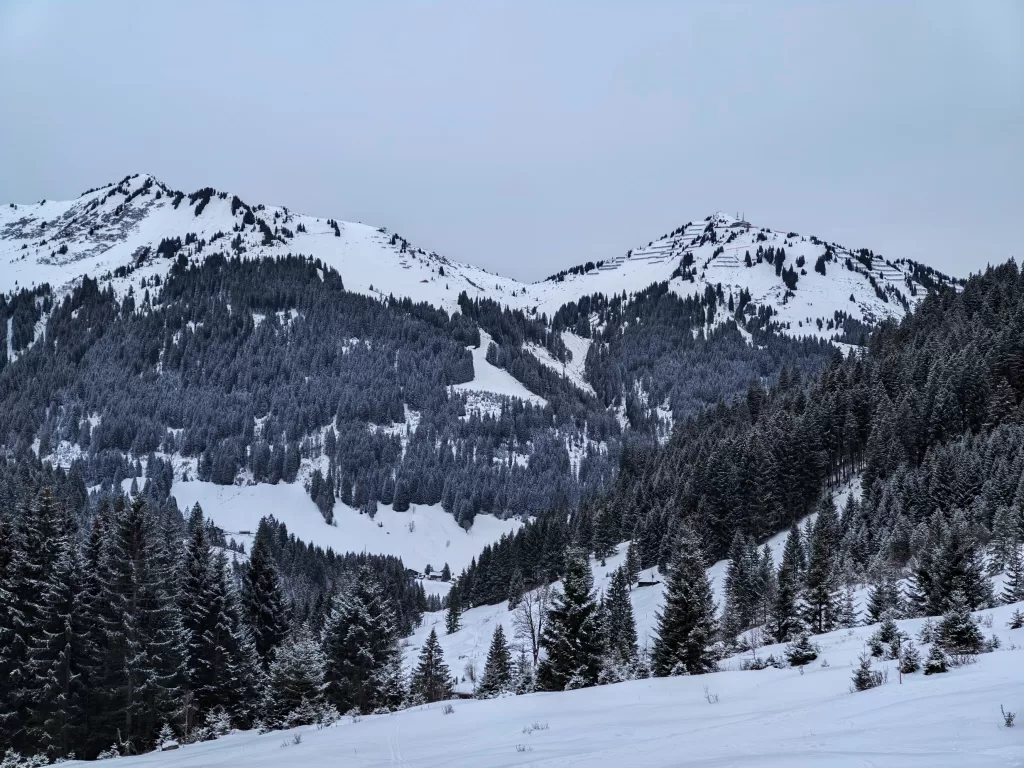 Before long, I was in solitude, accompanied only by the mountains and the snow. It was in this moment of insignificance that I felt a profound connection with nature. Eventually, the trail curved back to the creek, which was the point I decided to head back.
Before long, I was in solitude, accompanied only by the mountains and the snow. It was in this moment of insignificance that I felt a profound connection with nature. Eventually, the trail curved back to the creek, which was the point I decided to head back.
Overall, this “hiking” route is quite leisurely and ideal for those who wish to experience nature without a challenging hike. Yet, for the more adventurous, pursuing the trail towards the mountains offers the possibility of reaching the other side of Austria after a more difficult climb.
Mittelberg
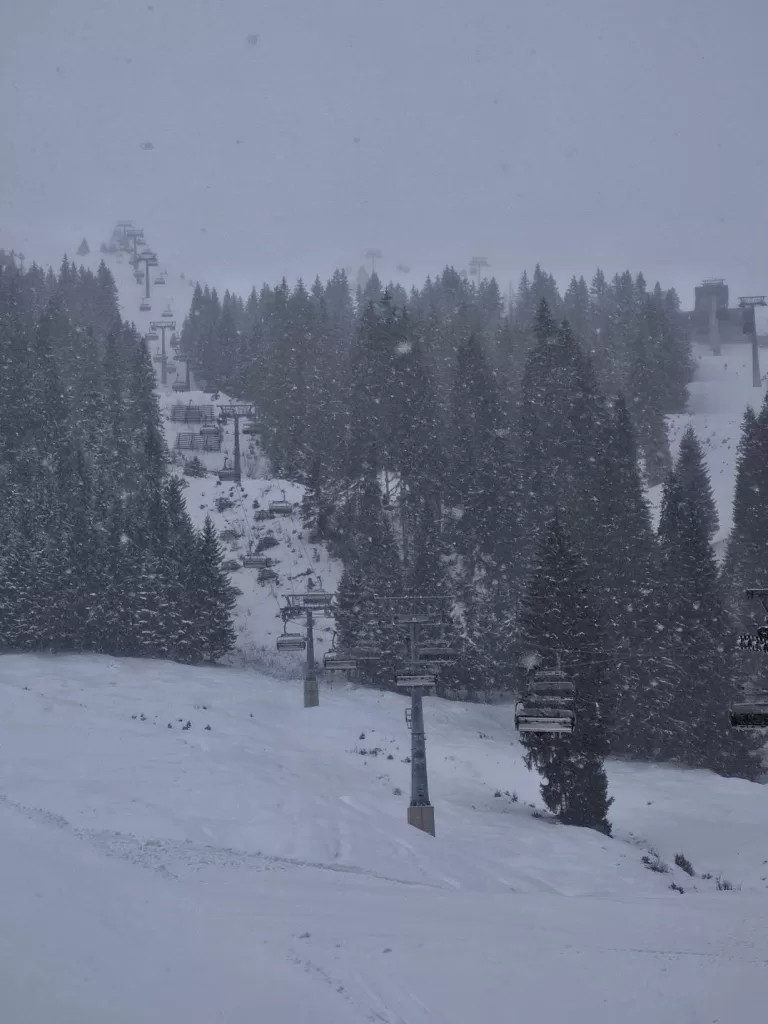 In a subsequent adventure, my husband and I embarked on a genuine hike, starting from the Ifen-Kleinwalsertal, a cable car station renowned for skiing, with the Schwarzwasserhütte at 1651 meters as our destination. This trail is also featured on Kleinwalsertal’s Official Website, but we opted for just half of the route. The journey to the Hütte and back took us approximately four hours, a duration that might be shortened under normal conditions, but we had to deal with heavy snow.
In a subsequent adventure, my husband and I embarked on a genuine hike, starting from the Ifen-Kleinwalsertal, a cable car station renowned for skiing, with the Schwarzwasserhütte at 1651 meters as our destination. This trail is also featured on Kleinwalsertal’s Official Website, but we opted for just half of the route. The journey to the Hütte and back took us approximately four hours, a duration that might be shortened under normal conditions, but we had to deal with heavy snow.
We set out from the Ifen-Kleinwalsertal. Hundreds of skiers ascended with the Ifen Bahn to the peak to ski back down. 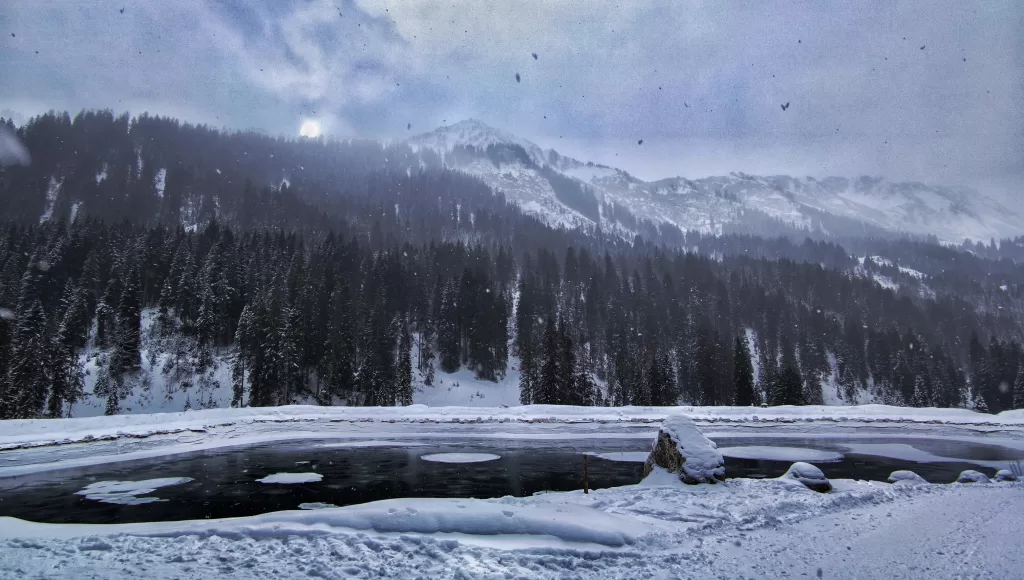 We navigated across the piste, then turned left onto a smaller snow-covered path. With thick snow blanketing everything in Alpine winter, warm winter hiking gear is essential. Along the way, we encountered an artificial lake, a reservoir for snow cannons used in maintaining ski slopes.
We navigated across the piste, then turned left onto a smaller snow-covered path. With thick snow blanketing everything in Alpine winter, warm winter hiking gear is essential. Along the way, we encountered an artificial lake, a reservoir for snow cannons used in maintaining ski slopes.
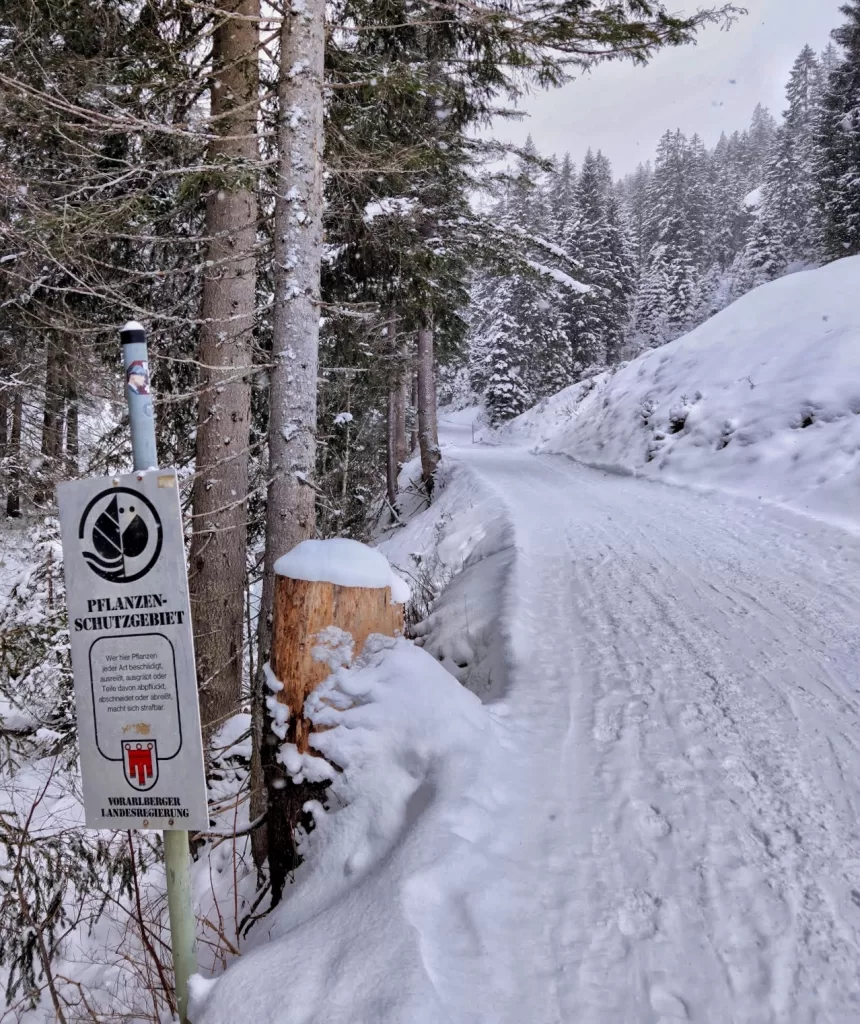 Past the lake, we entered a wooded area within an environmental protection zone. Here, the utmost respect for nature is required, damaging any plants is a crime, so leave nature untouched! The forest trek was moderate and enjoyable for any hiker.
Past the lake, we entered a wooded area within an environmental protection zone. Here, the utmost respect for nature is required, damaging any plants is a crime, so leave nature untouched! The forest trek was moderate and enjoyable for any hiker.
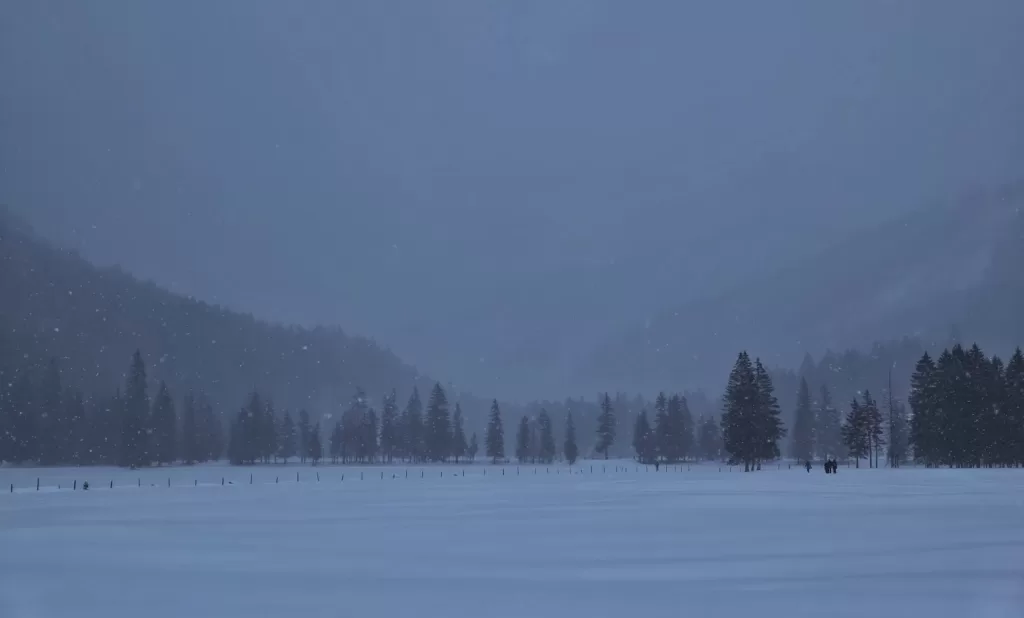 Exiting the woods, a vast snowy field unfolded before us. Under the snow was a grass field, its details hidden by the winter blanket. The deep snow proved challenging to navigate, as each step sank into the softness, often above knee level. We followed the compacted trail of previous hikers, which provided firmer footing compared to the untouched snow. Easier for skiers using their boards to slide!
Exiting the woods, a vast snowy field unfolded before us. Under the snow was a grass field, its details hidden by the winter blanket. The deep snow proved challenging to navigate, as each step sank into the softness, often above knee level. We followed the compacted trail of previous hikers, which provided firmer footing compared to the untouched snow. Easier for skiers using their boards to slide!
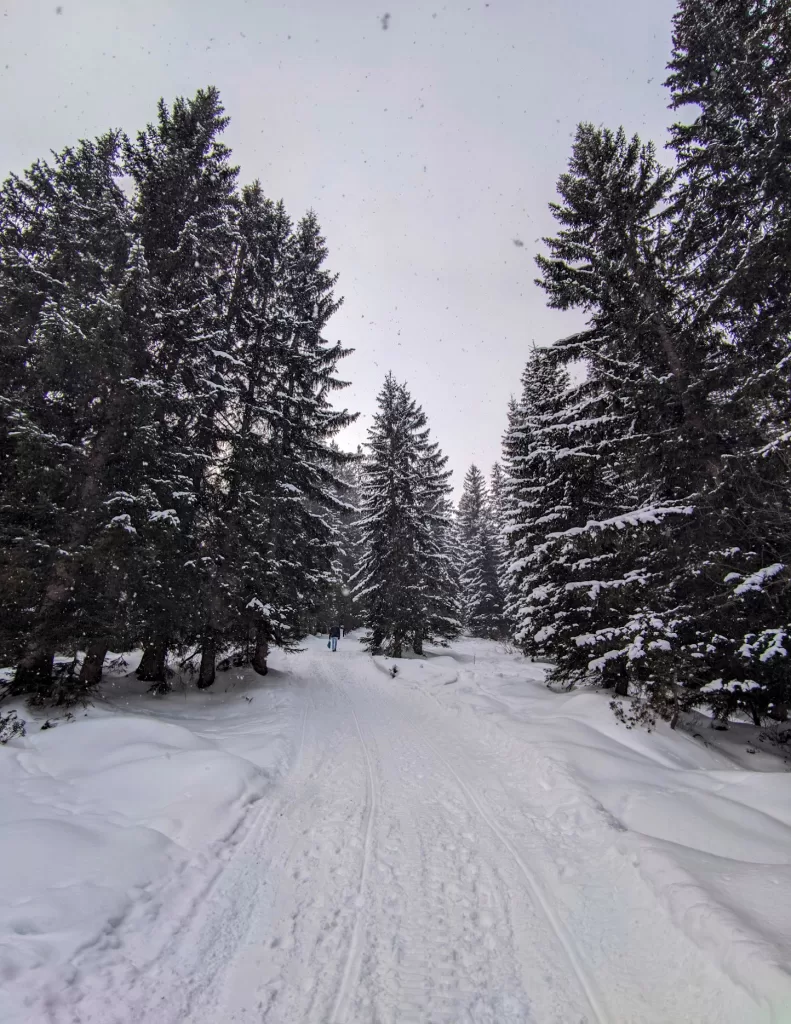
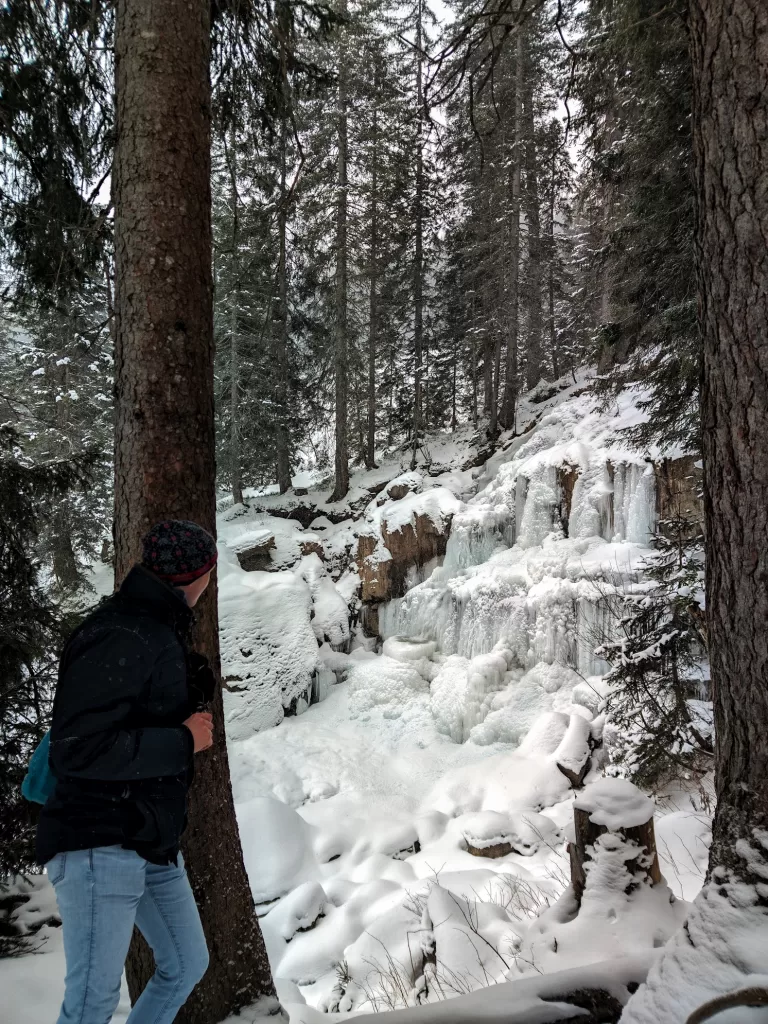 After passing the closed Melköde Alpe restaurant, we began a steep climb. The slope varied between 20 to 30 degrees, and the icy slippery path demanded careful footwork, especially without trekking poles. Next to the beginning of our ascent was the Schwarzwasserbach Fall, a waterfall frozen into a silent cascade – a spectacle unlike any I had witnessed before.
After passing the closed Melköde Alpe restaurant, we began a steep climb. The slope varied between 20 to 30 degrees, and the icy slippery path demanded careful footwork, especially without trekking poles. Next to the beginning of our ascent was the Schwarzwasserbach Fall, a waterfall frozen into a silent cascade – a spectacle unlike any I had witnessed before.
I’d been begging for a flatter path ahead, but the climb was relentless, slope after slope, each one testing my endurance. 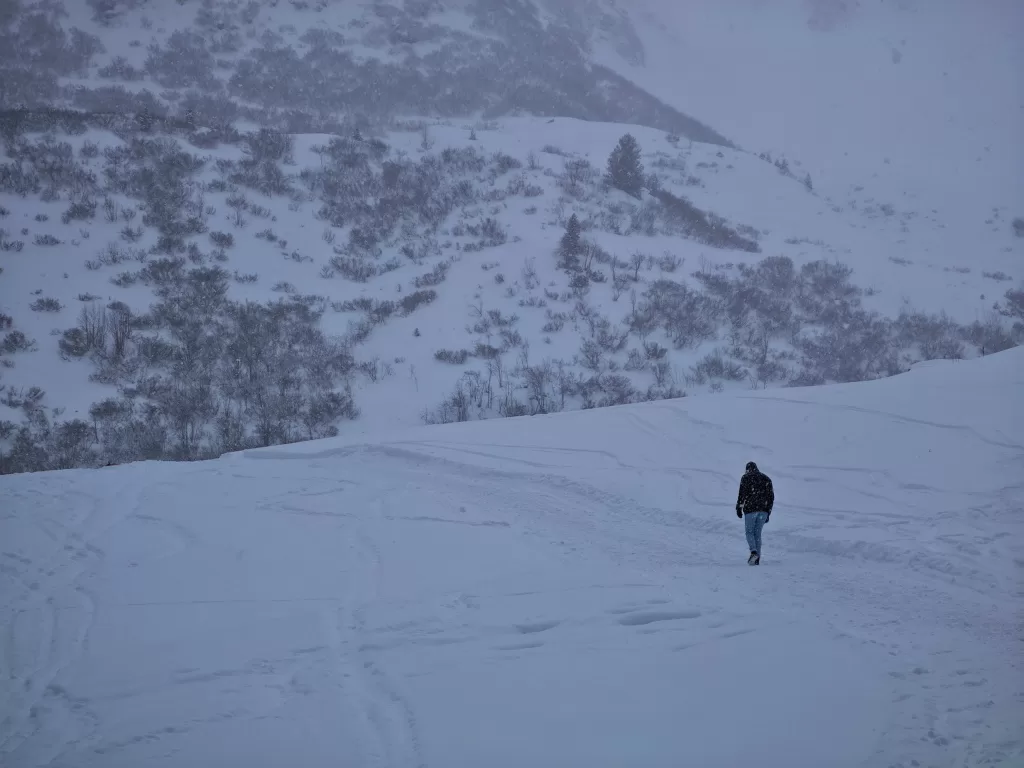 Normally keen to document my experiences, I found myself too exhausted to even photograph the surroundings. The only focus was on the ascent, and all I thought was to climb and stay alive. With heavier snow, we stopped talking, and I barely remember that exhausting ascent – it was almost traumatizing.
Normally keen to document my experiences, I found myself too exhausted to even photograph the surroundings. The only focus was on the ascent, and all I thought was to climb and stay alive. With heavier snow, we stopped talking, and I barely remember that exhausting ascent – it was almost traumatizing.
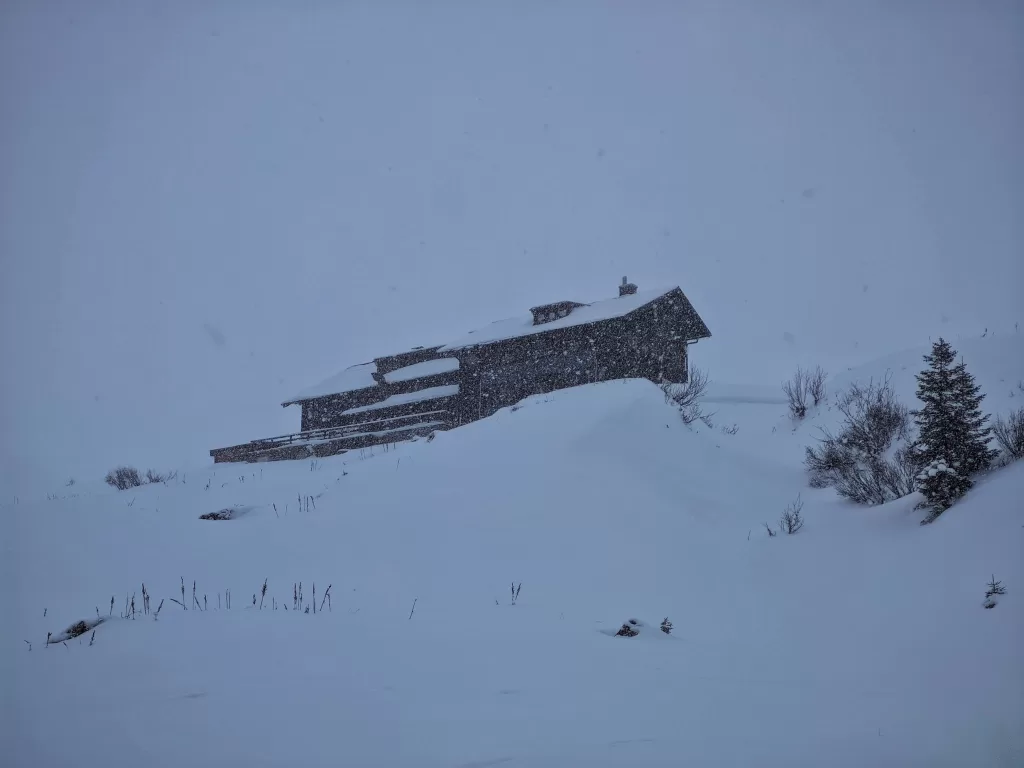 At last, the Schwarzwasserhütte came into view soon after we were out of the woods, perched halfway up another hill. It seemed a world away. I zoomed in for a photograph, which made the Hütte loom larger and somehow more accessible. That visual encounter sparked a renewed strength within us to go on. Navigating the winding S-shaped path, with each turn, the Hütte became closer, growing steadily from a spot on the horizon to a welcoming wooden house.
At last, the Schwarzwasserhütte came into view soon after we were out of the woods, perched halfway up another hill. It seemed a world away. I zoomed in for a photograph, which made the Hütte loom larger and somehow more accessible. That visual encounter sparked a renewed strength within us to go on. Navigating the winding S-shaped path, with each turn, the Hütte became closer, growing steadily from a spot on the horizon to a welcoming wooden house.
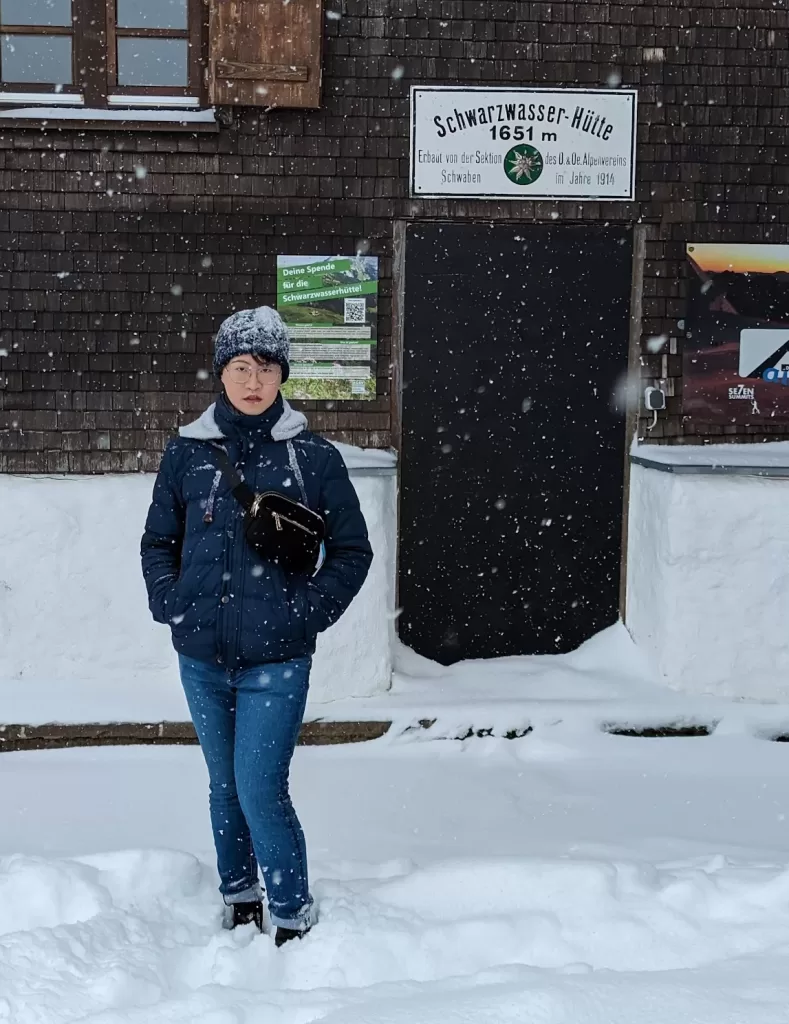 Our arrival at the Hütte was a quiet triumph – I felt joy but too exhausted to make a happy face. These mountain shelters are harbors for hikers to pause and recharge, often providing cozy dormitory-style lodging for those wishing to stay overnight. Bring cash! We barely had enough for a snack!
Our arrival at the Hütte was a quiet triumph – I felt joy but too exhausted to make a happy face. These mountain shelters are harbors for hikers to pause and recharge, often providing cozy dormitory-style lodging for those wishing to stay overnight. Bring cash! We barely had enough for a snack!
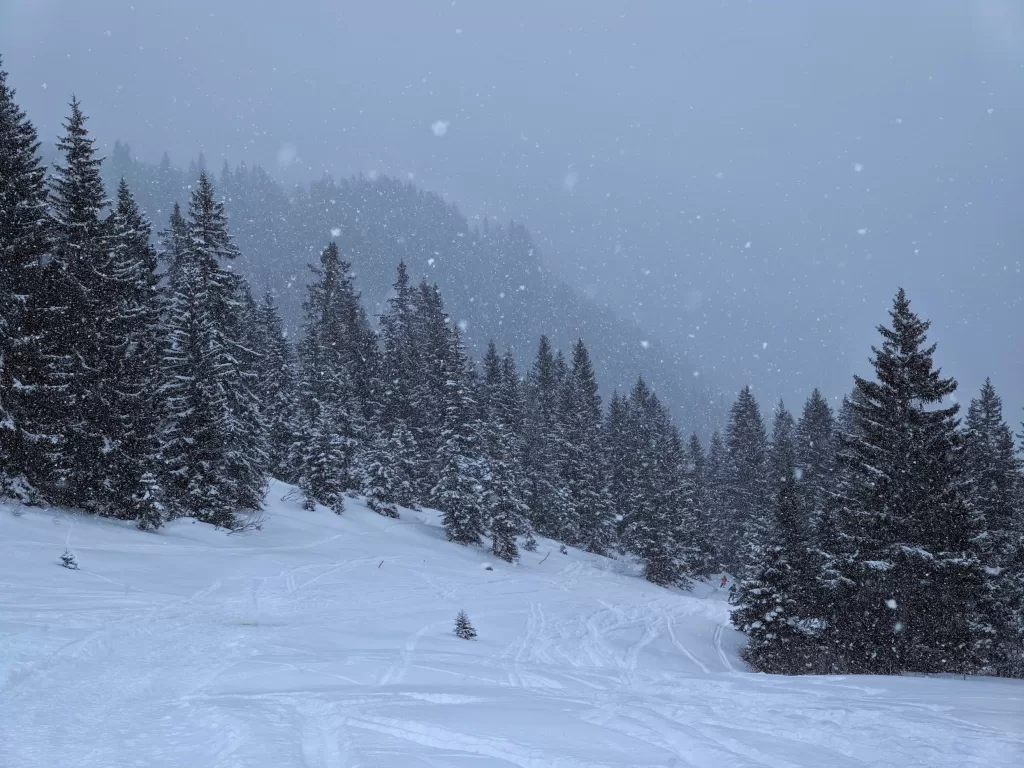 The descent was no easier. The snow, relentless in its descent, transformed the path into a treacherous slide. Without the right gear, I found myself involuntarily slipping down the slopes. Upon our return, I napped for nearly 2 hours before having the strength to go out for dinner.
The descent was no easier. The snow, relentless in its descent, transformed the path into a treacherous slide. Without the right gear, I found myself involuntarily slipping down the slopes. Upon our return, I napped for nearly 2 hours before having the strength to go out for dinner.
Compared to my Garmisch-Partenkirchen and Schloss Lichtenstein hikes, this was the hardest yet, with the steep slopes and heavy snow.
Mountain peaks
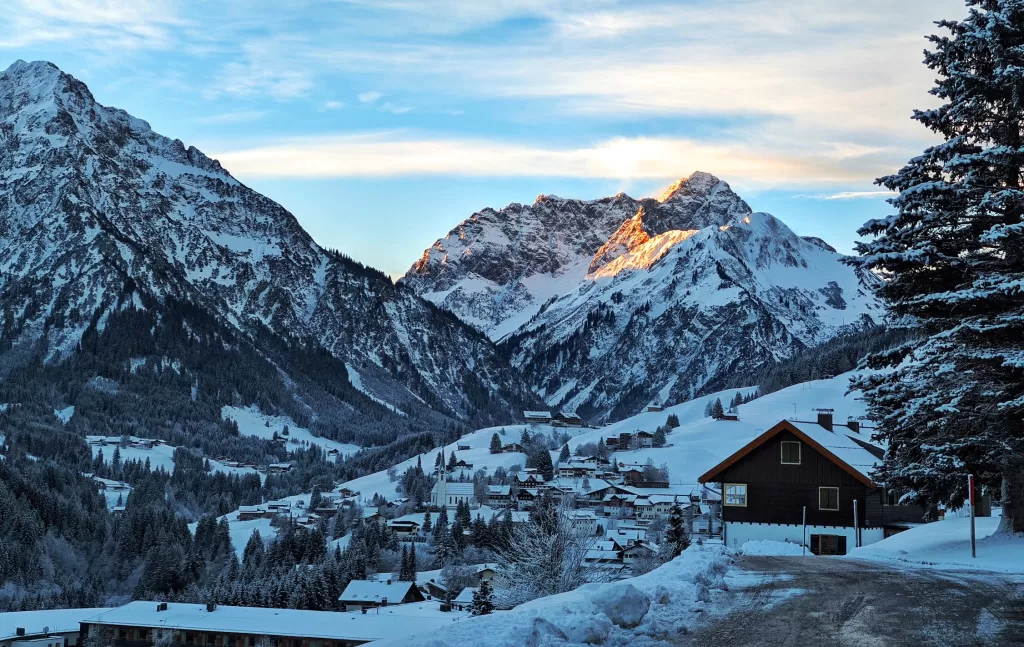 Kleinwalsertal’s landscape is dominated by magnificent mountains. Peaks like Elferkopf, Hoher Ifen, Kanzelwand, and Fellhorn, soaring to around 2000 meters, offer access by cable cars, as well as opportunities for hiking and climbing.
Kleinwalsertal’s landscape is dominated by magnificent mountains. Peaks like Elferkopf, Hoher Ifen, Kanzelwand, and Fellhorn, soaring to around 2000 meters, offer access by cable cars, as well as opportunities for hiking and climbing.
Our choice was Kanzelwand, appealing for several reasons: its proximity, the ease of access by cable car, and the unique position at the Austrian-German border, promising panoramic views of both the valley and the Allgäu region. The presence of the stunning high-altitude lake Riezler Alpsee and a trail to the peak Gehrenspitze added to its attraction, though I confess my naivety about what awaited us.
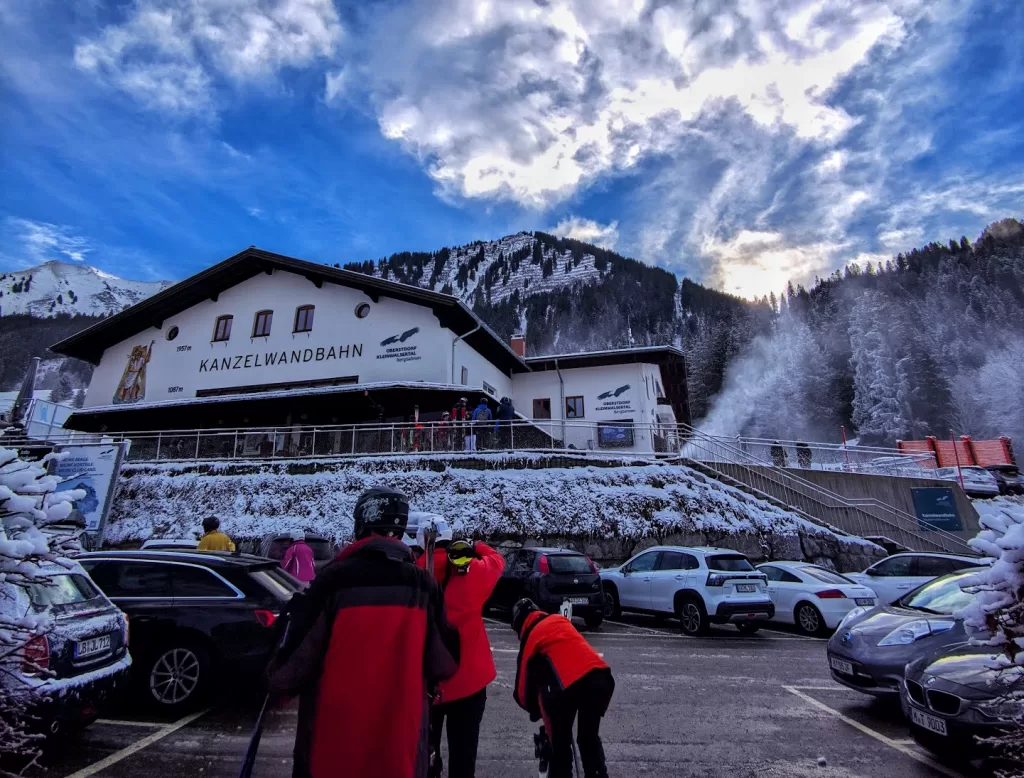 We boarded the cable car at Kanzelwandbahn, where no one was not wearing ski gear. The ride itself was intimidating , my mind forming visions of a catastrophic plunge down the mountainside – vowing internally to never repeat such an experience ever again in my life.
We boarded the cable car at Kanzelwandbahn, where no one was not wearing ski gear. The ride itself was intimidating , my mind forming visions of a catastrophic plunge down the mountainside – vowing internally to never repeat such an experience ever again in my life.
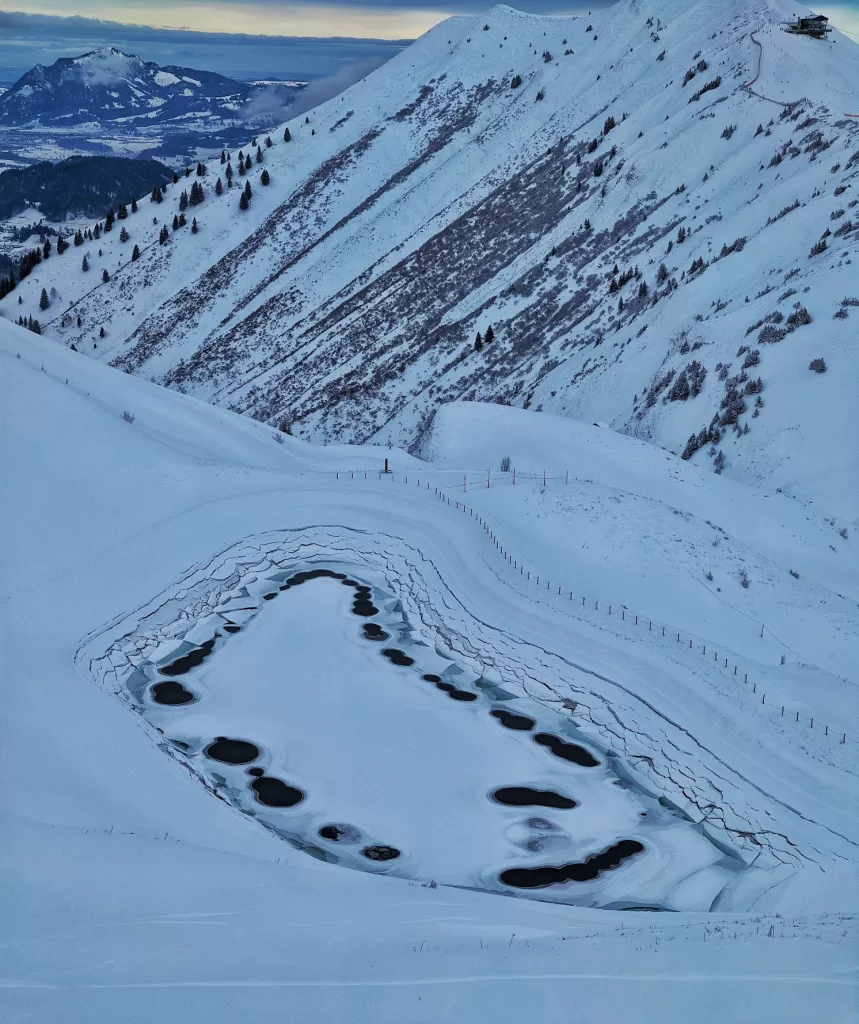
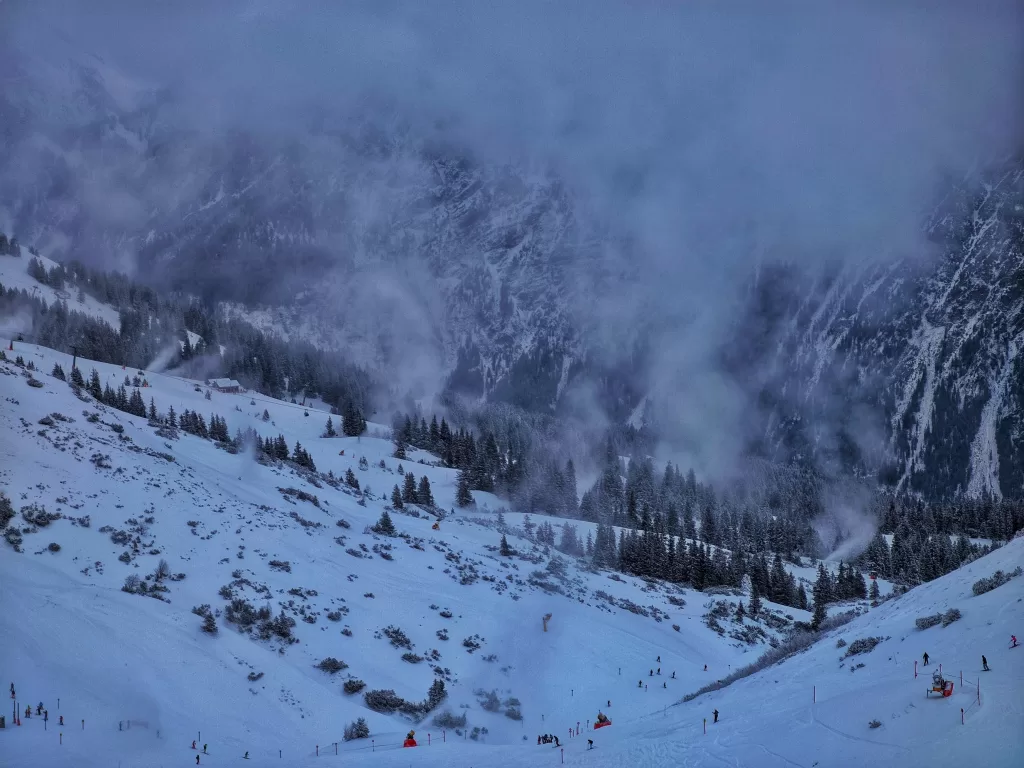 The summit presented a monochrome world of gray and white. The lake was frozen, and the intended paths were invisible, swallowed by snow and fog, which also obscured the chances of capturing the scenery in photos. Nothing was more humiliating than this. We stayed at the Panoramarestaurant Kanzelwand for some hot drinks, gathering our nerves before braving the cable car descent.
The summit presented a monochrome world of gray and white. The lake was frozen, and the intended paths were invisible, swallowed by snow and fog, which also obscured the chances of capturing the scenery in photos. Nothing was more humiliating than this. We stayed at the Panoramarestaurant Kanzelwand for some hot drinks, gathering our nerves before braving the cable car descent.
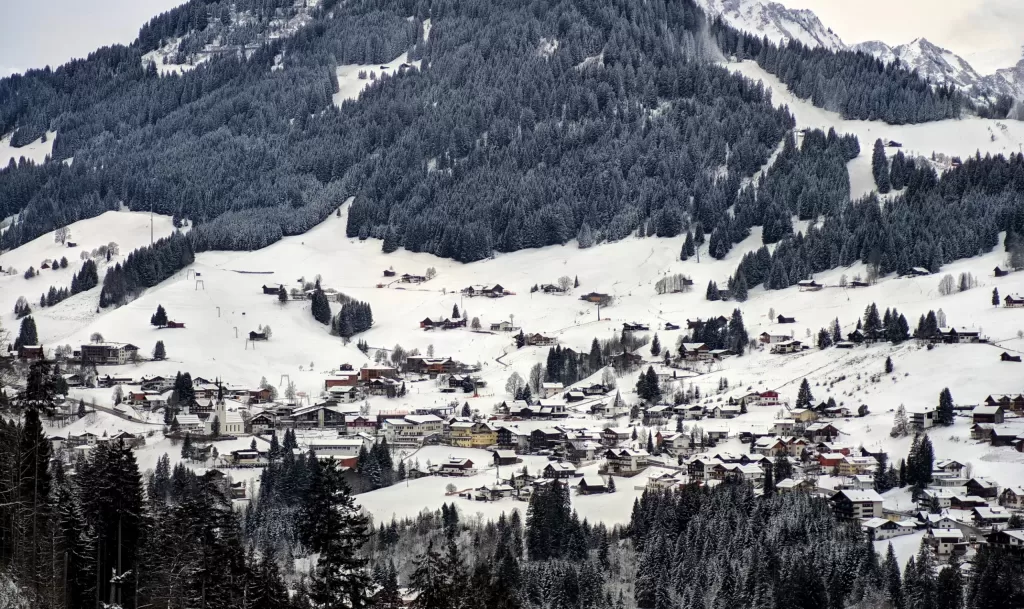
Even though the cable car scared me, I was still able to take some good pictures because the view from up high was really impressive.
Skiing
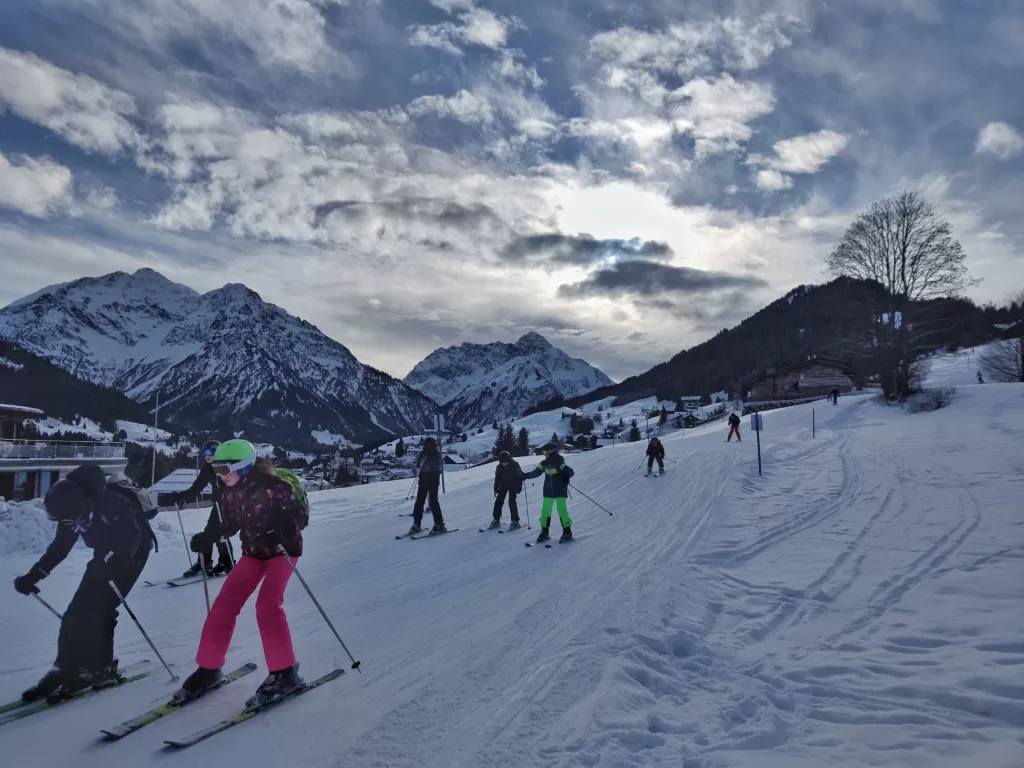 Winter transforms the valley into a skier’s paradise. It seemed we were the outliers among those hundreds of skiers. There’s a wide array of slopes descending from every peak and hill, stretching from the start of the valley to its deepest reaches. You can find a full guide to the ski routes, prices, and the operating hours of cable cars and lifts on Kleinwalsertal’s Website. For beginners, there are plenty of ski schools in each village, so you’re in good hands if you’re just starting out.
Winter transforms the valley into a skier’s paradise. It seemed we were the outliers among those hundreds of skiers. There’s a wide array of slopes descending from every peak and hill, stretching from the start of the valley to its deepest reaches. You can find a full guide to the ski routes, prices, and the operating hours of cable cars and lifts on Kleinwalsertal’s Website. For beginners, there are plenty of ski schools in each village, so you’re in good hands if you’re just starting out.
Casino
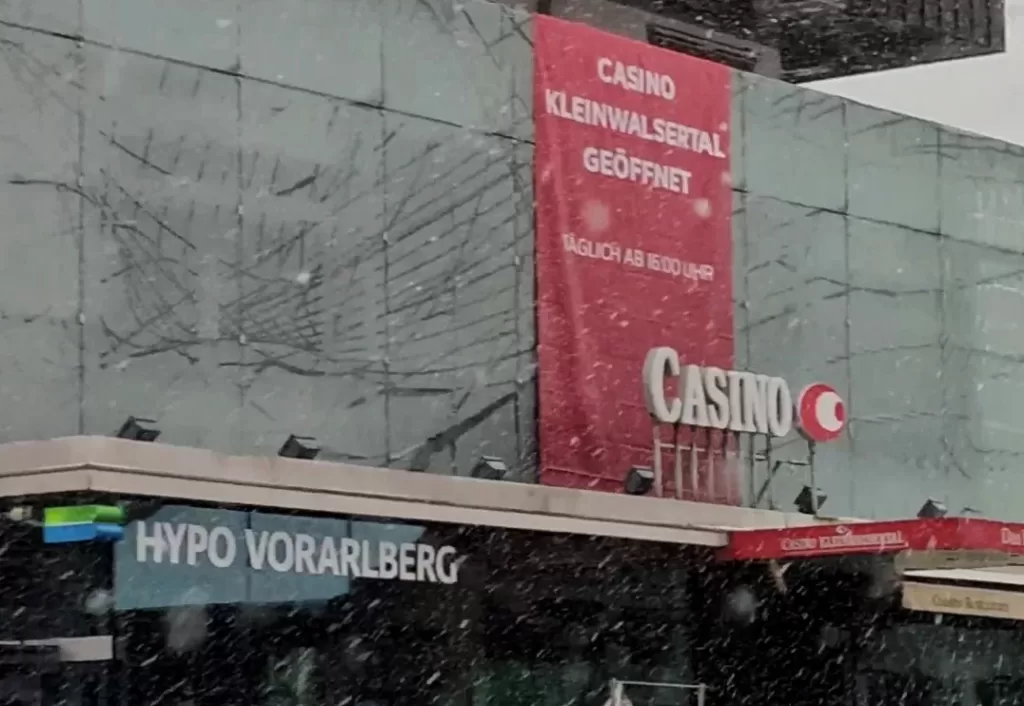 For evening entertainment, the Casino Kleinwalsertal is a popular spot among visitors. It offers a variety of games, food, and drinks. Make sure to check the opening hours and what services they offer on their website.
For evening entertainment, the Casino Kleinwalsertal is a popular spot among visitors. It offers a variety of games, food, and drinks. Make sure to check the opening hours and what services they offer on their website.
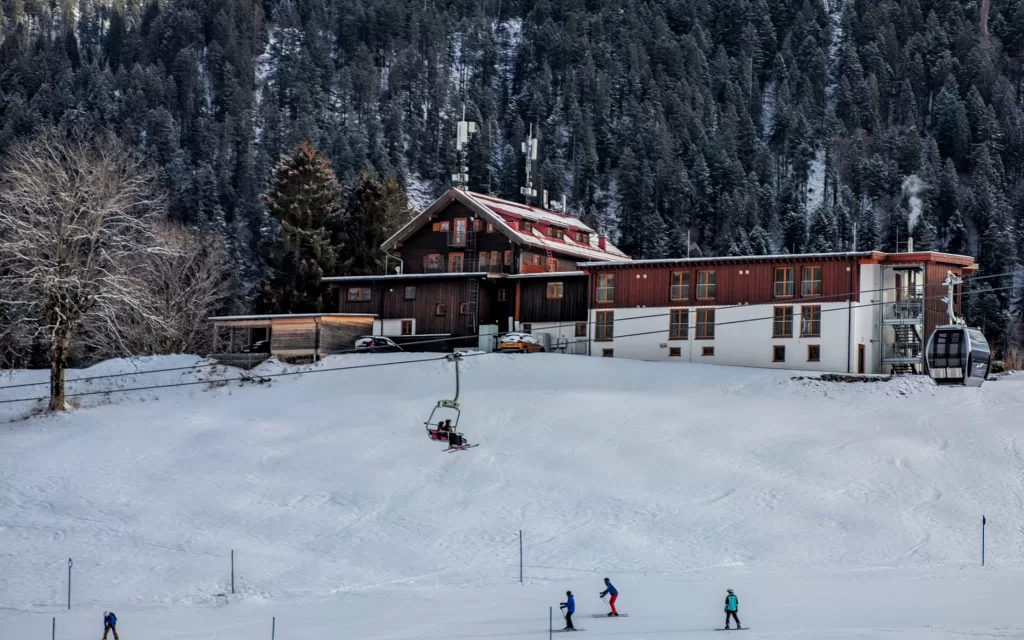
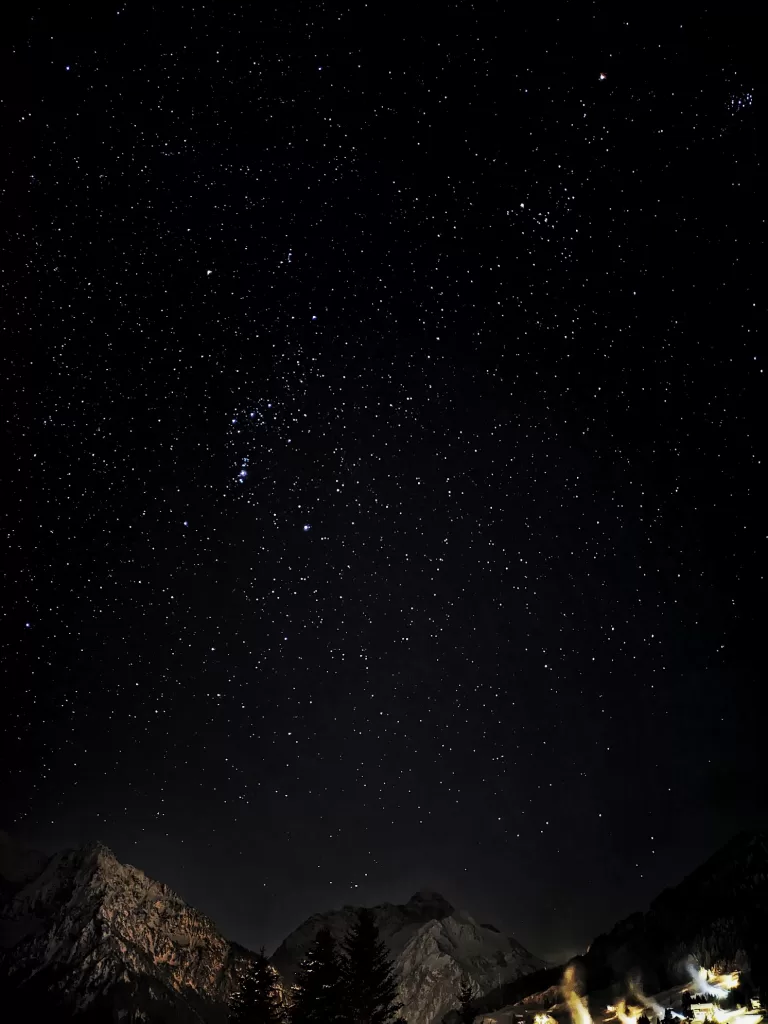 Overall, Kleinwalsertal is a hidden Shangri-La in the Allgäu Alps of Austria with abundant activities, especially in winter and summer. For someone like me, who loves the Alps and quaint villages, I found this secluded valley a recharging escape. Hard to imagine mental troubles existing in such a serene place!
Overall, Kleinwalsertal is a hidden Shangri-La in the Allgäu Alps of Austria with abundant activities, especially in winter and summer. For someone like me, who loves the Alps and quaint villages, I found this secluded valley a recharging escape. Hard to imagine mental troubles existing in such a serene place!
Kleinwalsertal: Austria’s Hidden Alpine Treasure

Kleinwalsertal is an Alpine valley in Austria, uniquely accessible only from Germany. Yes, this enclave is a geographical curiosity, entirely separated from the rest of Austria. Nestled in the Alps, it’s a prime spot for skiing. My husband had a conference in Hirschegg, which offered us a fantastic opportunity to reconnect with the mountains – a sentiment I’ve shared in a previous blog about Garmisch-Partenkirchen.
Best time to visit: Winter 🏂🏼 & (perhaps) Summer ⛰️
While the alpine region is breathtaking from late spring to winter, Kleinwalsertal becomes a tourist hotspot primarily in the winter for skiing. Consequently, many local businesses, including restaurants and shops, operate mainly during the ski season. I personally don’t ski, finding it somewhat dangerous, but the area has a variety of other activities. Summer, too, is ideal for hiking in the Alps, though it’s advisable to verify the availability of hiking gear in advance.
How to get there:
Bayern (Bavaria) is well-connected, with routes from München Hbf (Munich’s main station) leading nearly everywhere in the region. To reach Kleinwalsertal, take one of the various trains from Munich to Oberstdorf, the nearest major town at the German-Austrian border. For precise train connections and schedules, consult Deutsche Bahn’s website. Upon arrival at Oberstdorf Busbahnhof (bus station), take Bus 1 towards Kleinwalsertal Baad, Österreich.
As noted earlier, Kleinwalsertal comprises a sequence of small villages stretched along a main road. Bus 1 conveniently carries passengers from Riezlern, at the valley’s entrance, to Baad, at its terminus.

Let me guide you through what I believe are the best activities in Kleinwalsertal:
Hiking Opportunities:
Surrounded almost entirely by the Allgäu Alps, Kleinwalsertal offers an abundance of hiking trails suitable for both winter and summer excursions. We received a hiking guide from our accommodation, however, the Kleinwalsertal Official Website provides a wealth of information on trails that are accessible online at no charge. During my stay, I embarked on two distinct trails, one around Baad and another near Mittelberg.
Baad
Situated at the very end of the valley, Baad may give the deceptive impression of proximity to the other side of the country. Yet, when you arrive, you’re greeted by an imposing mountain range that blocks passage.
My adventure in Baad was rather spontaneous: I chose a path at random and let it guide me. The journey began at the Baad bus stop, located at the head of a trail. After snapping a photo of the trail map, I set off.

The path commenced alongside a creek – a flat and easy walk that soon became dull.

Seeking more excitement, I found an opportunity to ascend at a junction.

For those less inclined towards strenuous hikes, continuing along the creek remains a pleasant option. Although I’m not an avid hiker like the locals, the attraction of a mountain vista from higher ground was irresistible.The initial climb was sharp, offering rapid views of the surrounding peaks.

Before long, I was in solitude, accompanied only by the mountains and the snow. It was in this moment of insignificance that I felt a profound connection with nature. Eventually, the trail curved back to the creek, which was the point I decided to head back.
Overall, this “hiking” route is quite leisurely and ideal for those who wish to experience nature without a challenging hike. Yet, for the more adventurous, pursuing the trail towards the mountains offers the possibility of reaching the other side of Austria after a more difficult climb.
Mittelberg
In a subsequent adventure, my husband and I embarked on a genuine hike, starting from the Ifen-Kleinwalsertal, a cable car station renowned for skiing, with the Schwarzwasserhütte at 1651 meters as our destination. This trail is also featured on Kleinwalsertal’s Official Website, but we opted for just half of the route. The journey to the Hütte and back took us approximately four hours, a duration that might be shortened under normal conditions, but we had to deal with heavy snow.
We set out from the Ifen-Kleinwalsertal. Hundreds of skiers ascended with the Ifen Bahn to the peak to ski back down.

We navigated across the piste, then turned left onto a smaller snow-covered path. With thick snow blanketing everything in Alpine winter, warm winter hiking gear is essential. Along the way, we encountered an artificial lake, a reservoir for snow cannons used in maintaining ski slopes.

Past the lake, we entered a wooded area within an environmental protection zone. Here, the utmost respect for nature is required, damaging any plants is a crime, so leave nature untouched!

The forest trek was moderate and enjoyable for any hiker.
Exiting the woods, a vast snowy field unfolded before us. Under the snow was a grass field, its details hidden by the winter blanket. The deep snow proved challenging to navigate, as each step sank into the softness, often above knee level.

We followed the compacted trail of previous hikers, which provided firmer footing compared to the untouched snow. Easier for skiers using their boards to slide!
After passing the closed Melköde Alpe restaurant, we began a steep climb. The slope varied between 20 to 30 degrees, and the icy slippery path demanded careful footwork, especially without trekking poles.

Next to the beginning of our ascent was the Schwarzwasserbach Fall, a waterfall frozen into a silent cascade – a spectacle unlike any I had witnessed before.

I’d been begging for a flatter path ahead, but the climb was relentless, slope after slope, each one testing my endurance. Normally keen to document my experiences, I found myself too exhausted to even photograph the surroundings. The only focus was on the ascent, and all I thought was to climb and stay alive. With heavier snow, we stopped talking, and I barely remember that exhausting ascent – it was almost traumatizing.

At last, the Schwarzwasserhütte came into view soon after we were out of the woods, perched halfway up another hill. It seemed a world away. I zoomed in for a photograph, which made the Hütte loom larger and somehow more accessible.

That visual encounter sparked a renewed strength within us to go on. Navigating the winding S-shaped path, with each turn, the Hütte became closer, growing steadily from a spot on the horizon to a welcoming wooden house.
Our arrival at the Hütte was a quiet triumph – I felt joy but too exhausted to make a happy face.

These mountain shelters are harbors for hikers to pause and recharge, often providing cozy dormitory-style lodging for those wishing to stay overnight. Bring cash! We barely had enough for a snack!
The descent was no easier. The snow, relentless in its descent, transformed the path into a treacherous slide.

Without the right gear, I found myself involuntarily slipping down the slopes. Upon our return, I napped for nearly 2 hours before having the strength to go out for dinner.
Compared to my Garmisch-Partenkirchen and Schloss Lichtenstein hikes, this was the hardest yet, with the steep slopes and heavy snow.
Mountain peaks

Kleinwalsertal’s landscape is dominated by magnificent mountains. Peaks like Elferkopf, Hoher Ifen, Kanzelwand, and Fellhorn, soaring to around 2000 meters, offer access by cable cars, as well as opportunities for hiking and climbing.
Our choice was Kanzelwand, appealing for several reasons: its proximity, the ease of access by cable car, and the unique position at the Austrian-German border, promising panoramic views of both the valley and the Allgäu region. The presence of the stunning high-altitude lake Riezler Alpsee and a trail to the peak Gehrenspitze added to its attraction, though I confess my naivety about what awaited us.
We boarded the cable car at Kanzelwandbahn, where no one was not wearing ski gear.

The ride itself was intimidating , my mind forming visions of a catastrophic plunge down the mountainside – vowing internally to never repeat such an experience ever again in my life.
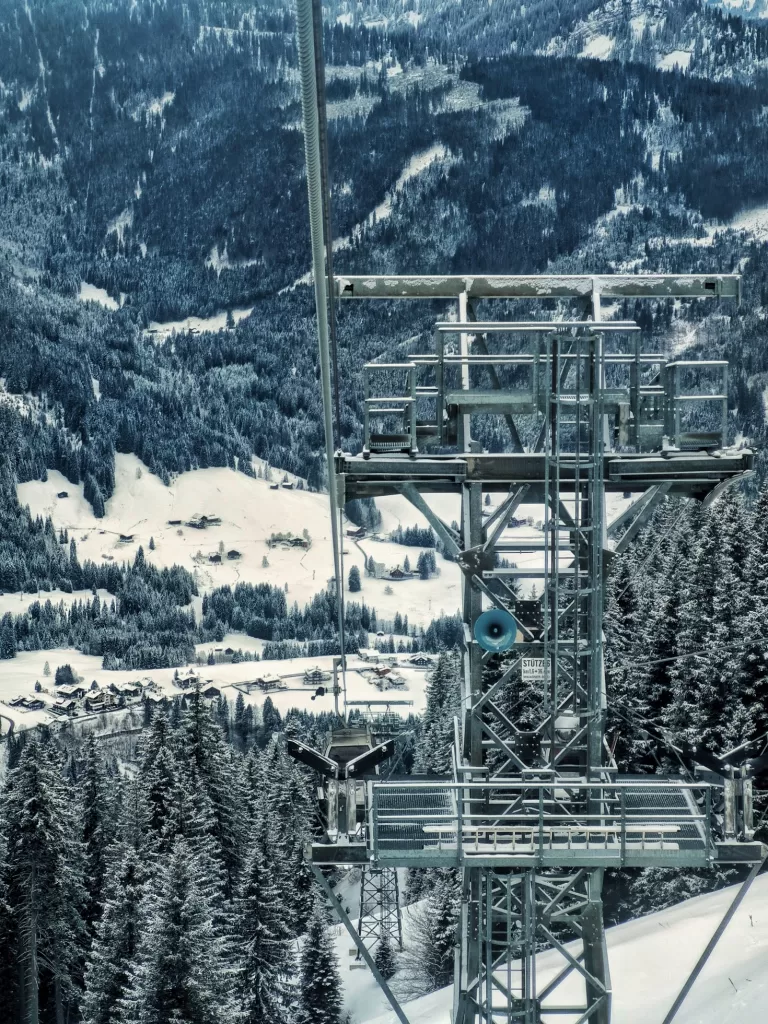
The summit presented a monochrome world of gray and white. The lake was frozen, and the intended paths were invisible, swallowed by snow and fog, which also obscured the chances of capturing the scenery in photos.

Nothing was more humiliating than this. We stayed at the Panoramarestaurant Kanzelwand for some hot drinks, gathering our nerves before braving the cable car descent.

Even though the cable car scared me, I was still able to take some good pictures because the view from up high was really impressive.

Skiing
Winter transforms the valley into a skier’s paradise. It seemed we were the outliers among those hundreds of skiers. There’s a wide array of slopes descending from every peak and hill, stretching from the start of the valley to its deepest reaches. You can find a full guide to the ski routes, prices, and the operating hours of cable cars and lifts on Kleinwalsertal’s Website. For beginners, there are plenty of ski schools in each village, so you’re in good hands if you’re just starting out.

Casino
For evening entertainment, the Casino Kleinwalsertal is a popular spot among visitors. It offers a variety of games, food, and drinks. Make sure to check the opening hours and what services they offer on their website.


Overall, Kleinwalsertal is a hidden Shangri-La in the Allgäu Alps of Austria with abundant activities, especially in winter and summer. For someone like me, who loves the Alps and quaint villages, I found this secluded valley a recharging escape. Hard to imagine mental troubles existing in such a serene place!
